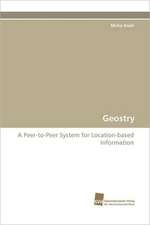Harbour Protection Through Data Fusion Technologies: NATO Science for Peace and Security Series C: Environmental Security
Editat de Elisa Shahbazian, Galina Rogova, Michael J. de Weerten Limba Engleză Paperback – 27 noi 2008
| Toate formatele și edițiile | Preț | Express |
|---|---|---|
| Paperback (1) | 1270.25 lei 6-8 săpt. | |
| SPRINGER NETHERLANDS – 27 noi 2008 | 1270.25 lei 6-8 săpt. | |
| Hardback (1) | 1276.70 lei 6-8 săpt. | |
| SPRINGER NETHERLANDS – 2 dec 2008 | 1276.70 lei 6-8 săpt. |
Din seria NATO Science for Peace and Security Series C: Environmental Security
- 18%
 Preț: 1106.00 lei
Preț: 1106.00 lei - 15%
 Preț: 659.70 lei
Preț: 659.70 lei - 18%
 Preț: 999.60 lei
Preț: 999.60 lei - 18%
 Preț: 1221.07 lei
Preț: 1221.07 lei - 18%
 Preț: 1220.75 lei
Preț: 1220.75 lei - 18%
 Preț: 940.39 lei
Preț: 940.39 lei - 18%
 Preț: 1216.78 lei
Preț: 1216.78 lei - 18%
 Preț: 1232.71 lei
Preț: 1232.71 lei - 18%
 Preț: 1818.02 lei
Preț: 1818.02 lei - 18%
 Preț: 1833.95 lei
Preț: 1833.95 lei - 18%
 Preț: 1231.47 lei
Preț: 1231.47 lei - 18%
 Preț: 942.44 lei
Preț: 942.44 lei - 18%
 Preț: 1218.06 lei
Preț: 1218.06 lei - 18%
 Preț: 1383.00 lei
Preț: 1383.00 lei - 15%
 Preț: 664.29 lei
Preț: 664.29 lei - 18%
 Preț: 1220.88 lei
Preț: 1220.88 lei - 24%
 Preț: 1040.01 lei
Preț: 1040.01 lei - 18%
 Preț: 1222.80 lei
Preț: 1222.80 lei - 18%
 Preț: 1220.75 lei
Preț: 1220.75 lei - 18%
 Preț: 1224.85 lei
Preț: 1224.85 lei - 18%
 Preț: 1224.85 lei
Preț: 1224.85 lei - 18%
 Preț: 1224.68 lei
Preț: 1224.68 lei - 18%
 Preț: 963.15 lei
Preț: 963.15 lei - 18%
 Preț: 1229.10 lei
Preț: 1229.10 lei - 18%
 Preț: 1222.49 lei
Preț: 1222.49 lei - 18%
 Preț: 1223.74 lei
Preț: 1223.74 lei - 18%
 Preț: 1213.65 lei
Preț: 1213.65 lei - 18%
 Preț: 956.33 lei
Preț: 956.33 lei - 18%
 Preț: 1235.43 lei
Preț: 1235.43 lei - 18%
 Preț: 940.39 lei
Preț: 940.39 lei - 18%
 Preț: 1210.63 lei
Preț: 1210.63 lei - 18%
 Preț: 1219.63 lei
Preț: 1219.63 lei - 18%
 Preț: 1225.48 lei
Preț: 1225.48 lei - 18%
 Preț: 1228.75 lei
Preț: 1228.75 lei - 18%
 Preț: 1228.62 lei
Preț: 1228.62 lei - 18%
 Preț: 1222.94 lei
Preț: 1222.94 lei - 18%
 Preț: 962.98 lei
Preț: 962.98 lei - 18%
 Preț: 1218.06 lei
Preț: 1218.06 lei - 15%
 Preț: 643.99 lei
Preț: 643.99 lei - 18%
 Preț: 1220.12 lei
Preț: 1220.12 lei - 18%
 Preț: 1233.52 lei
Preț: 1233.52 lei - 18%
 Preț: 946.24 lei
Preț: 946.24 lei - 18%
 Preț: 1218.21 lei
Preț: 1218.21 lei - 18%
 Preț: 953.65 lei
Preț: 953.65 lei
Preț: 1270.25 lei
Preț vechi: 1587.81 lei
-20% Nou
Puncte Express: 1905
Preț estimativ în valută:
243.06€ • 254.46$ • 201.12£
243.06€ • 254.46$ • 201.12£
Carte tipărită la comandă
Livrare economică 05-19 aprilie
Preluare comenzi: 021 569.72.76
Specificații
ISBN-13: 9781402088827
ISBN-10: 1402088825
Pagini: 384
Ilustrații: XX, 360 p.
Dimensiuni: 155 x 235 x 21 mm
Greutate: 0.54 kg
Ediția:2009
Editura: SPRINGER NETHERLANDS
Colecția Springer
Seria NATO Science for Peace and Security Series C: Environmental Security
Locul publicării:Dordrecht, Netherlands
ISBN-10: 1402088825
Pagini: 384
Ilustrații: XX, 360 p.
Dimensiuni: 155 x 235 x 21 mm
Greutate: 0.54 kg
Ediția:2009
Editura: SPRINGER NETHERLANDS
Colecția Springer
Seria NATO Science for Peace and Security Series C: Environmental Security
Locul publicării:Dordrecht, Netherlands
Public țintă
ResearchCuprins
CEP and Transport PB&Cs.- Implementation of the ISPS Code in Norwegian Ports.- Practical Implementation of the ISPS Code in the French Seaports.- PBIST and Its Projects, with Focus on Port Security.- Implementation of the ISPS Code in the Russian Federation: Ships and Ports.- Steps to Better Waterside Port and Harbor Security: The Development of Regional Maritime Safety Systems in the Russian Federation.- Police National Maritime Security Strategy.- Harbour Protection in the Jordanian Port of Aqaba.- Feasibility Study on Surveillance and Interdiction Technologies for the Port of Halifax.- Maritime Surveillance Information Availability in Estonia.- Case Study: The Reality of DF Technology Transition for Maritime Domain Awareness with a Focus on Container Security.- Cerberus.- Emerging Sensor Technologies and Metrics for Harbour Security.- Low Power Modular Sonar Systems.- An Unconstrained View of the Employment and Exploitation of Defence Data Fusion Technologies for Harbour Protection.- An Approach to Threat Assessment.- Harbour Protection and Higher Level Fusion: Issues and Approaches.- Perceptual Reasoning Managed Situation Assessment for Harbour Protection.- Understanding Military Information Processing — An Approach to Support Intelligence in Defence and Security.- Applying Decision Support and Data/Information Fusion/Management Concepts for Emergency Response in the Context of Harbour Protection.- Analyses of the Concept of Trust in Information Fusion and Situation Assessment.- Issues with Developing Situation and Threat Assessment Capabilities.- Distributed Data Fusion and Maritime Domain Awareness for Harbour Protection.- Intelligent Geo-Information Systems and Harbour Protection.- Using Modeling and Simulation as a Framework for Testing New Solutions Devotedto Securing Global Flows of Goods and People.- Fusion of Information from Disparate Electro-Optical Imagers for Maritime Surveillance.- Automatic Video Surveillance of Harbour Structures.- Heterogeneous Sensors Data Fusion Issues for Harbour Security.- Ship Detection and Characterization Using Polarimetric SAR Data.- Quick Joint Detection and Fusion Applications in Passive Surveillance Systems.- The Quiet Interlude Processing System (QuIPS) — An Automated Data Fusion Capability for Littoral Environments.- Sensor Data Processing for Tracking Underwater Threats Using Terascale Optical Core Devices.- A New Neural Approach for Pattern Recognition in Space Imagery.- Concurrent Self-Organizing Maps — A Powerful Artificial Neural Tool for Biometric Technology.- Sensor-Fusion in Neural Networks.- Target Identification Based on DSmT.- Particle Filter Application to Localization.- Restrictive Estimation in Tracking Problems.- Findings of the NATO Workshop on Data Fusion Technologies for Harbour Protection.
Caracteristici
Harbour/Port Protection Policy discussions Sensor Technologies to enhance Harbour/Port Security Information processing technologies to enhance Harbour/Port Security Methodologies, technologies and data/information fusion approaches to enhance Harbour/Port Security












